Corporate Accounting HI5020 Assessment 2: Retail Food Group Analysis
VerifiedAdded on 2021/05/27
|9
|2078
|102
Report
AI Summary
This report provides a comprehensive analysis of Retail Food Group's (RFG) financial statements for FY2017. It examines the cash flow statement, detailing receipts from customers, payments to suppliers and employees, and financing activities, highlighting the company's investments and financing strategies, including equity proceeds, borrowings, and dividend payments. The report also explores the other comprehensive income (OCI) statement, focusing on exchange differences and changes in the fair value of cash flow hedges, and discusses the rationale for recognizing these items in OCI. Furthermore, it delves into the accounting for corporate income tax, comparing the theoretical tax expense with the actual amount, analyzing deferred tax assets and liabilities, and explaining the differences between tax expense and tax payable. The analysis highlights the complexities of tax computation, the impact of accounting and tax norms, and the practical application of theoretical concepts, emphasizing the challenges in managing deferred tax assets and liabilities and the differences between accrual and cash accounting.
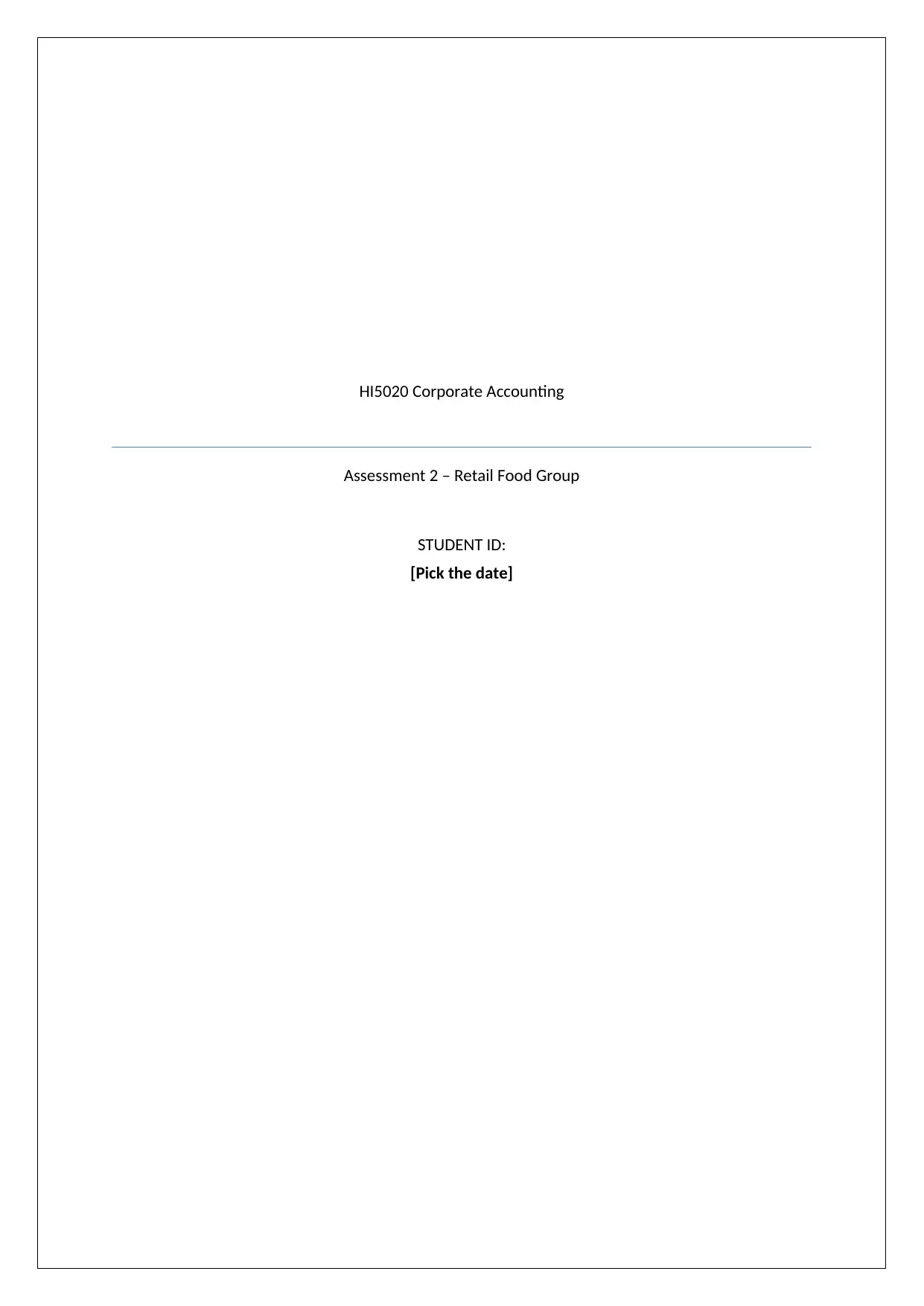
HI5020 Corporate Accounting
Assessment 2 – Retail Food Group
STUDENT ID:
[Pick the date]
Assessment 2 – Retail Food Group
STUDENT ID:
[Pick the date]
Paraphrase This Document
Need a fresh take? Get an instant paraphrase of this document with our AI Paraphraser
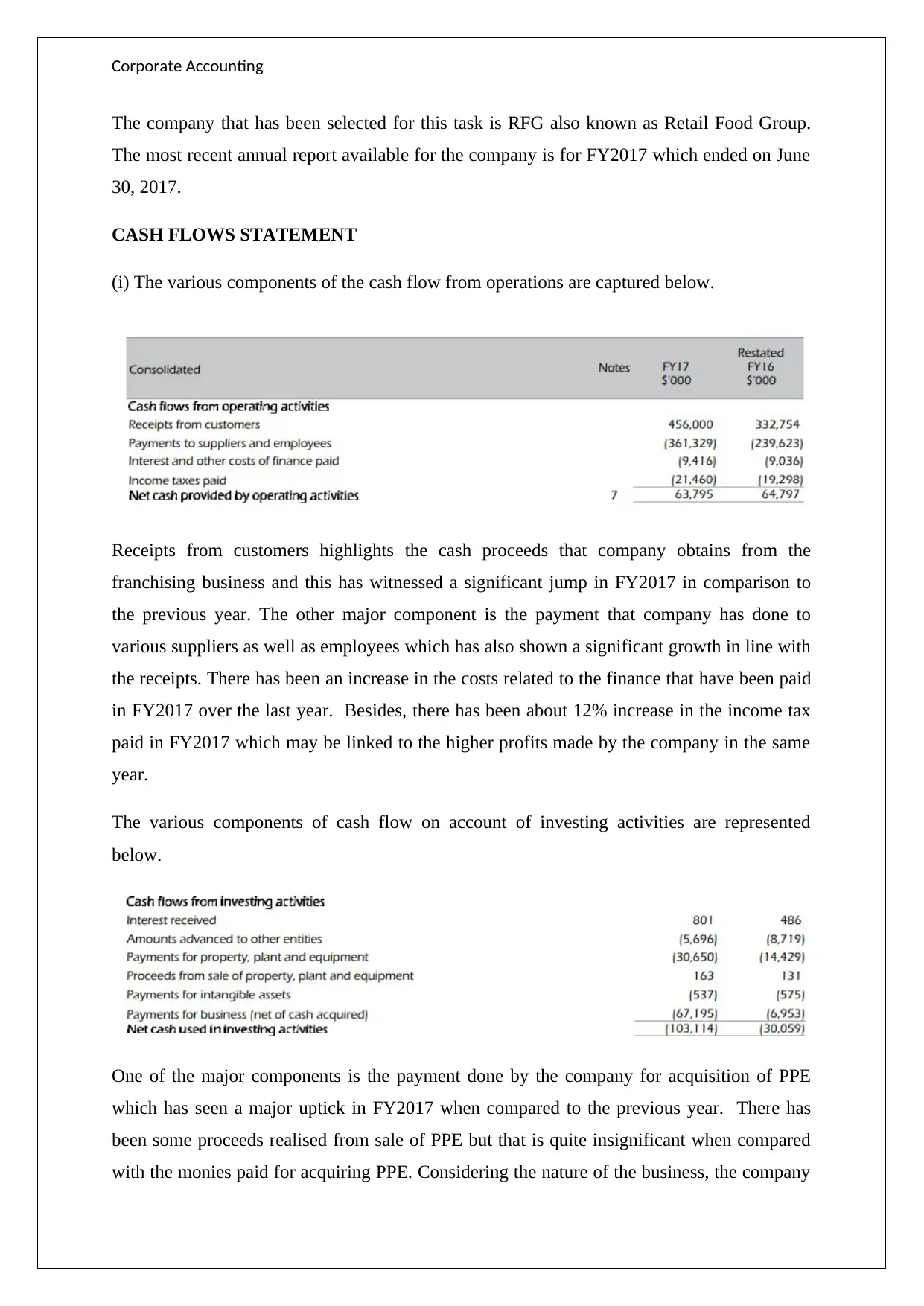
Corporate Accounting
The company that has been selected for this task is RFG also known as Retail Food Group.
The most recent annual report available for the company is for FY2017 which ended on June
30, 2017.
CASH FLOWS STATEMENT
(i) The various components of the cash flow from operations are captured below.
Receipts from customers highlights the cash proceeds that company obtains from the
franchising business and this has witnessed a significant jump in FY2017 in comparison to
the previous year. The other major component is the payment that company has done to
various suppliers as well as employees which has also shown a significant growth in line with
the receipts. There has been an increase in the costs related to the finance that have been paid
in FY2017 over the last year. Besides, there has been about 12% increase in the income tax
paid in FY2017 which may be linked to the higher profits made by the company in the same
year.
The various components of cash flow on account of investing activities are represented
below.
One of the major components is the payment done by the company for acquisition of PPE
which has seen a major uptick in FY2017 when compared to the previous year. There has
been some proceeds realised from sale of PPE but that is quite insignificant when compared
with the monies paid for acquiring PPE. Considering the nature of the business, the company
The company that has been selected for this task is RFG also known as Retail Food Group.
The most recent annual report available for the company is for FY2017 which ended on June
30, 2017.
CASH FLOWS STATEMENT
(i) The various components of the cash flow from operations are captured below.
Receipts from customers highlights the cash proceeds that company obtains from the
franchising business and this has witnessed a significant jump in FY2017 in comparison to
the previous year. The other major component is the payment that company has done to
various suppliers as well as employees which has also shown a significant growth in line with
the receipts. There has been an increase in the costs related to the finance that have been paid
in FY2017 over the last year. Besides, there has been about 12% increase in the income tax
paid in FY2017 which may be linked to the higher profits made by the company in the same
year.
The various components of cash flow on account of investing activities are represented
below.
One of the major components is the payment done by the company for acquisition of PPE
which has seen a major uptick in FY2017 when compared to the previous year. There has
been some proceeds realised from sale of PPE but that is quite insignificant when compared
with the monies paid for acquiring PPE. Considering the nature of the business, the company
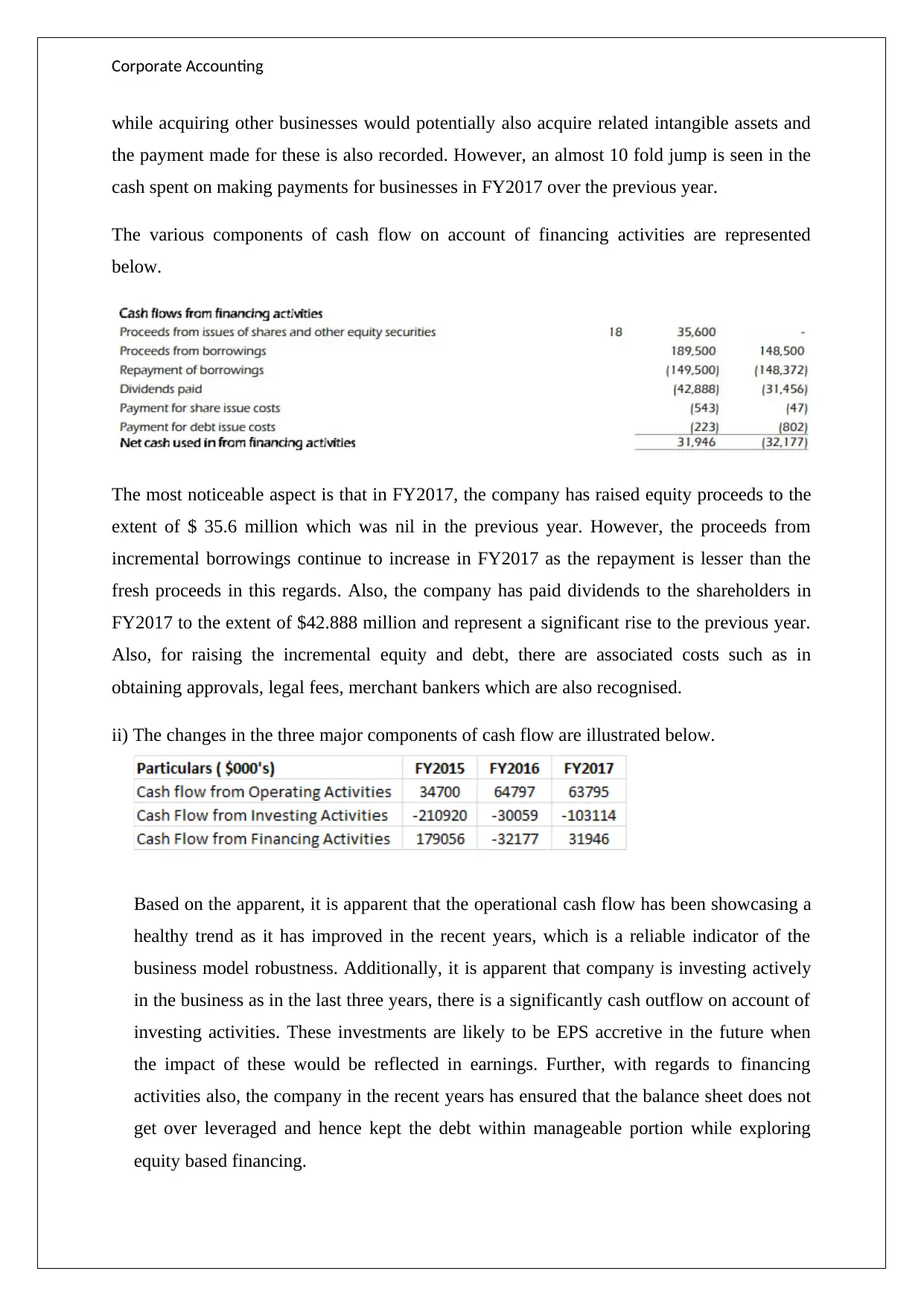
Corporate Accounting
while acquiring other businesses would potentially also acquire related intangible assets and
the payment made for these is also recorded. However, an almost 10 fold jump is seen in the
cash spent on making payments for businesses in FY2017 over the previous year.
The various components of cash flow on account of financing activities are represented
below.
The most noticeable aspect is that in FY2017, the company has raised equity proceeds to the
extent of $ 35.6 million which was nil in the previous year. However, the proceeds from
incremental borrowings continue to increase in FY2017 as the repayment is lesser than the
fresh proceeds in this regards. Also, the company has paid dividends to the shareholders in
FY2017 to the extent of $42.888 million and represent a significant rise to the previous year.
Also, for raising the incremental equity and debt, there are associated costs such as in
obtaining approvals, legal fees, merchant bankers which are also recognised.
ii) The changes in the three major components of cash flow are illustrated below.
Based on the apparent, it is apparent that the operational cash flow has been showcasing a
healthy trend as it has improved in the recent years, which is a reliable indicator of the
business model robustness. Additionally, it is apparent that company is investing actively
in the business as in the last three years, there is a significantly cash outflow on account of
investing activities. These investments are likely to be EPS accretive in the future when
the impact of these would be reflected in earnings. Further, with regards to financing
activities also, the company in the recent years has ensured that the balance sheet does not
get over leveraged and hence kept the debt within manageable portion while exploring
equity based financing.
while acquiring other businesses would potentially also acquire related intangible assets and
the payment made for these is also recorded. However, an almost 10 fold jump is seen in the
cash spent on making payments for businesses in FY2017 over the previous year.
The various components of cash flow on account of financing activities are represented
below.
The most noticeable aspect is that in FY2017, the company has raised equity proceeds to the
extent of $ 35.6 million which was nil in the previous year. However, the proceeds from
incremental borrowings continue to increase in FY2017 as the repayment is lesser than the
fresh proceeds in this regards. Also, the company has paid dividends to the shareholders in
FY2017 to the extent of $42.888 million and represent a significant rise to the previous year.
Also, for raising the incremental equity and debt, there are associated costs such as in
obtaining approvals, legal fees, merchant bankers which are also recognised.
ii) The changes in the three major components of cash flow are illustrated below.
Based on the apparent, it is apparent that the operational cash flow has been showcasing a
healthy trend as it has improved in the recent years, which is a reliable indicator of the
business model robustness. Additionally, it is apparent that company is investing actively
in the business as in the last three years, there is a significantly cash outflow on account of
investing activities. These investments are likely to be EPS accretive in the future when
the impact of these would be reflected in earnings. Further, with regards to financing
activities also, the company in the recent years has ensured that the balance sheet does not
get over leveraged and hence kept the debt within manageable portion while exploring
equity based financing.
⊘ This is a preview!⊘
Do you want full access?
Subscribe today to unlock all pages.

Trusted by 1+ million students worldwide
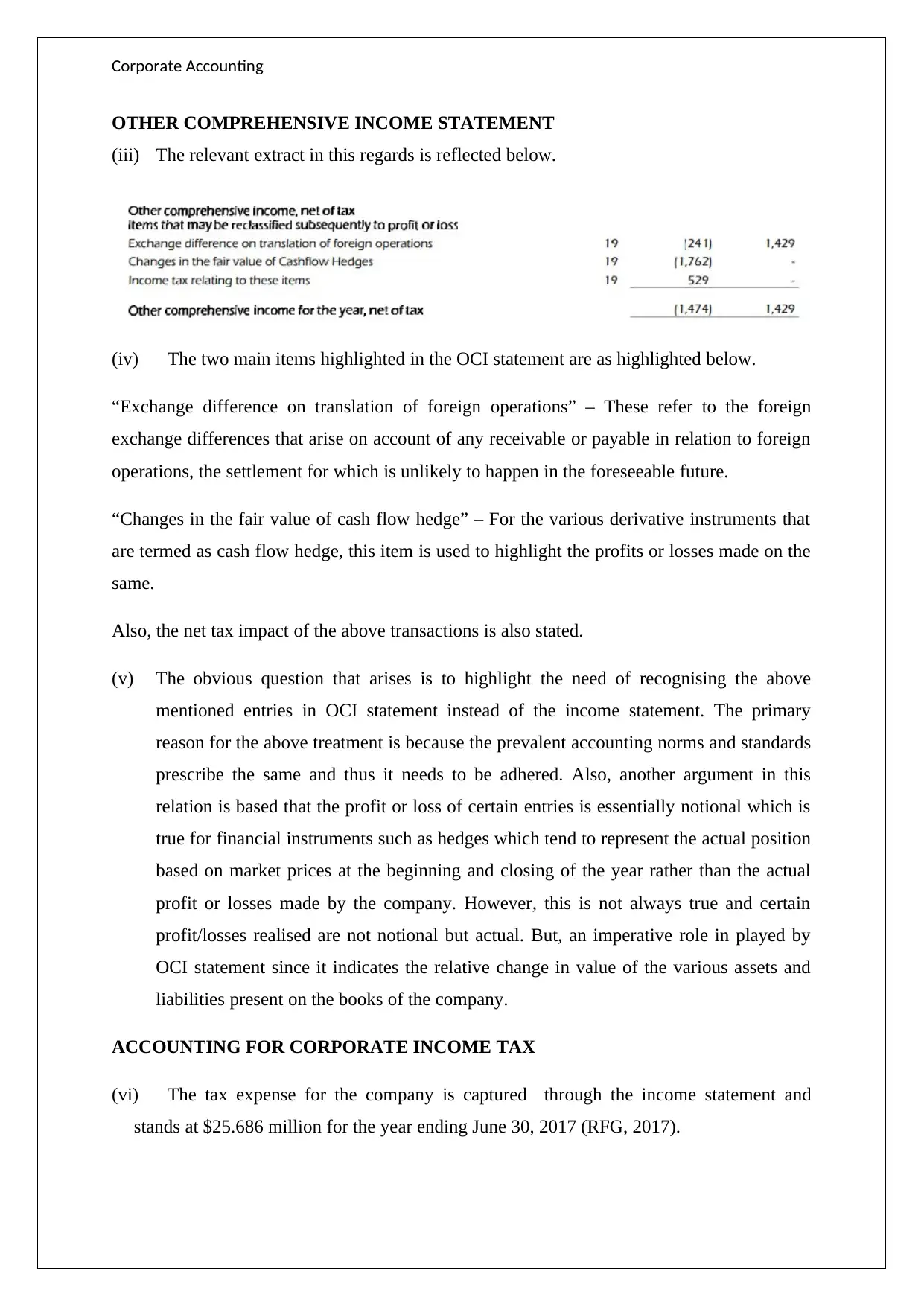
Corporate Accounting
OTHER COMPREHENSIVE INCOME STATEMENT
(iii) The relevant extract in this regards is reflected below.
(iv) The two main items highlighted in the OCI statement are as highlighted below.
“Exchange difference on translation of foreign operations” – These refer to the foreign
exchange differences that arise on account of any receivable or payable in relation to foreign
operations, the settlement for which is unlikely to happen in the foreseeable future.
“Changes in the fair value of cash flow hedge” – For the various derivative instruments that
are termed as cash flow hedge, this item is used to highlight the profits or losses made on the
same.
Also, the net tax impact of the above transactions is also stated.
(v) The obvious question that arises is to highlight the need of recognising the above
mentioned entries in OCI statement instead of the income statement. The primary
reason for the above treatment is because the prevalent accounting norms and standards
prescribe the same and thus it needs to be adhered. Also, another argument in this
relation is based that the profit or loss of certain entries is essentially notional which is
true for financial instruments such as hedges which tend to represent the actual position
based on market prices at the beginning and closing of the year rather than the actual
profit or losses made by the company. However, this is not always true and certain
profit/losses realised are not notional but actual. But, an imperative role in played by
OCI statement since it indicates the relative change in value of the various assets and
liabilities present on the books of the company.
ACCOUNTING FOR CORPORATE INCOME TAX
(vi) The tax expense for the company is captured through the income statement and
stands at $25.686 million for the year ending June 30, 2017 (RFG, 2017).
OTHER COMPREHENSIVE INCOME STATEMENT
(iii) The relevant extract in this regards is reflected below.
(iv) The two main items highlighted in the OCI statement are as highlighted below.
“Exchange difference on translation of foreign operations” – These refer to the foreign
exchange differences that arise on account of any receivable or payable in relation to foreign
operations, the settlement for which is unlikely to happen in the foreseeable future.
“Changes in the fair value of cash flow hedge” – For the various derivative instruments that
are termed as cash flow hedge, this item is used to highlight the profits or losses made on the
same.
Also, the net tax impact of the above transactions is also stated.
(v) The obvious question that arises is to highlight the need of recognising the above
mentioned entries in OCI statement instead of the income statement. The primary
reason for the above treatment is because the prevalent accounting norms and standards
prescribe the same and thus it needs to be adhered. Also, another argument in this
relation is based that the profit or loss of certain entries is essentially notional which is
true for financial instruments such as hedges which tend to represent the actual position
based on market prices at the beginning and closing of the year rather than the actual
profit or losses made by the company. However, this is not always true and certain
profit/losses realised are not notional but actual. But, an imperative role in played by
OCI statement since it indicates the relative change in value of the various assets and
liabilities present on the books of the company.
ACCOUNTING FOR CORPORATE INCOME TAX
(vi) The tax expense for the company is captured through the income statement and
stands at $25.686 million for the year ending June 30, 2017 (RFG, 2017).
Paraphrase This Document
Need a fresh take? Get an instant paraphrase of this document with our AI Paraphraser
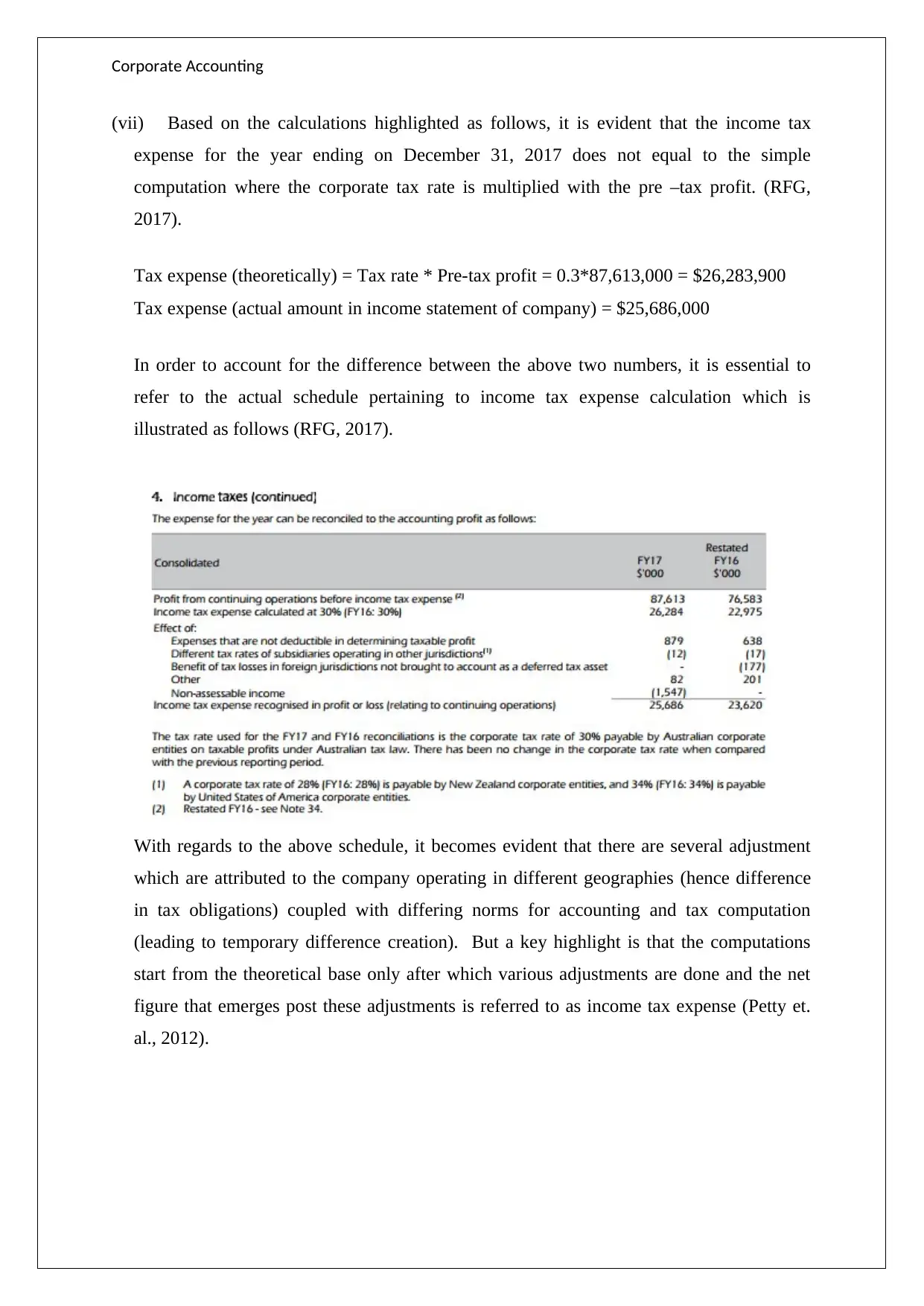
Corporate Accounting
(vii) Based on the calculations highlighted as follows, it is evident that the income tax
expense for the year ending on December 31, 2017 does not equal to the simple
computation where the corporate tax rate is multiplied with the pre –tax profit. (RFG,
2017).
Tax expense (theoretically) = Tax rate * Pre-tax profit = 0.3*87,613,000 = $26,283,900
Tax expense (actual amount in income statement of company) = $25,686,000
In order to account for the difference between the above two numbers, it is essential to
refer to the actual schedule pertaining to income tax expense calculation which is
illustrated as follows (RFG, 2017).
With regards to the above schedule, it becomes evident that there are several adjustment
which are attributed to the company operating in different geographies (hence difference
in tax obligations) coupled with differing norms for accounting and tax computation
(leading to temporary difference creation). But a key highlight is that the computations
start from the theoretical base only after which various adjustments are done and the net
figure that emerges post these adjustments is referred to as income tax expense (Petty et.
al., 2012).
(vii) Based on the calculations highlighted as follows, it is evident that the income tax
expense for the year ending on December 31, 2017 does not equal to the simple
computation where the corporate tax rate is multiplied with the pre –tax profit. (RFG,
2017).
Tax expense (theoretically) = Tax rate * Pre-tax profit = 0.3*87,613,000 = $26,283,900
Tax expense (actual amount in income statement of company) = $25,686,000
In order to account for the difference between the above two numbers, it is essential to
refer to the actual schedule pertaining to income tax expense calculation which is
illustrated as follows (RFG, 2017).
With regards to the above schedule, it becomes evident that there are several adjustment
which are attributed to the company operating in different geographies (hence difference
in tax obligations) coupled with differing norms for accounting and tax computation
(leading to temporary difference creation). But a key highlight is that the computations
start from the theoretical base only after which various adjustments are done and the net
figure that emerges post these adjustments is referred to as income tax expense (Petty et.
al., 2012).
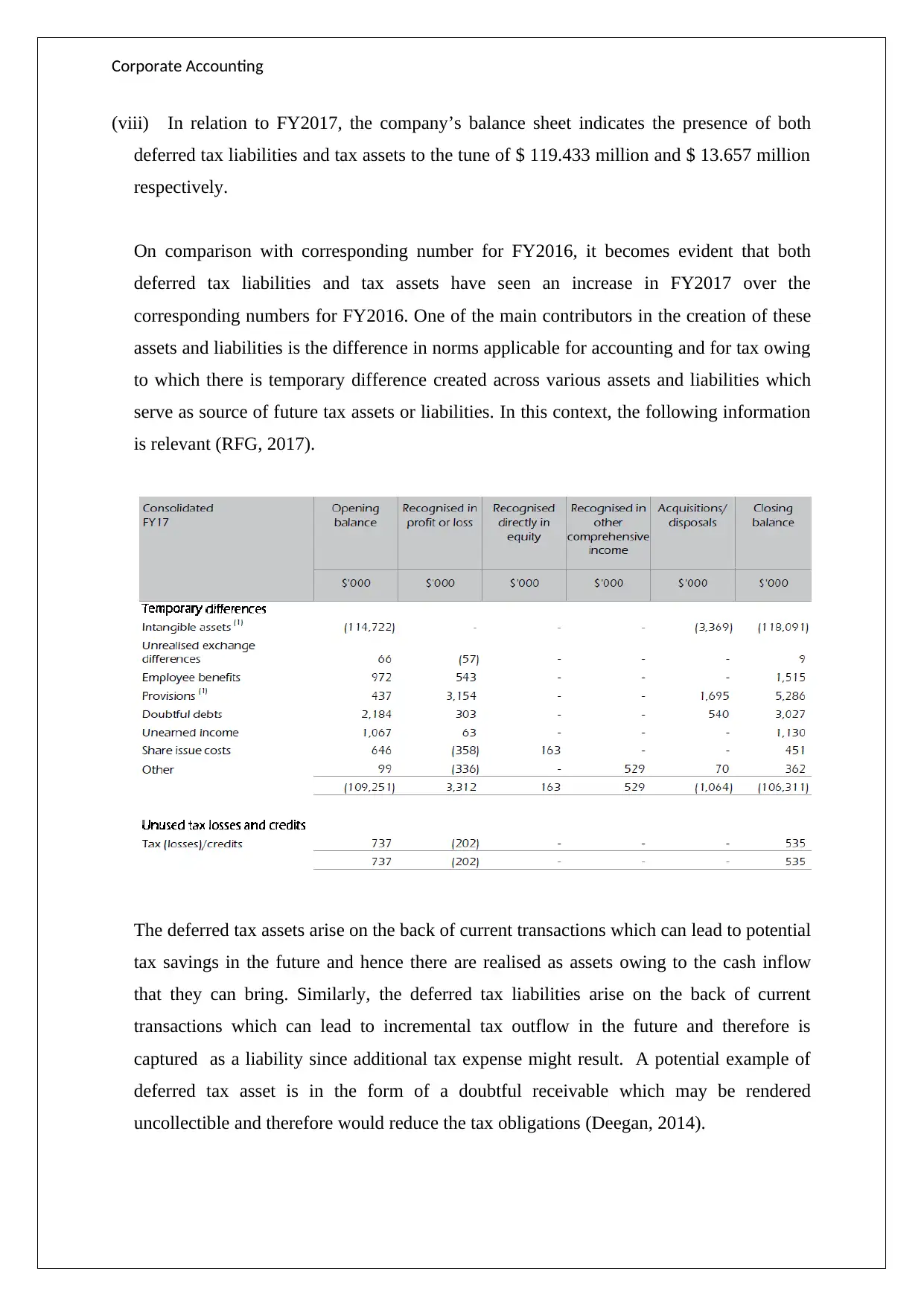
Corporate Accounting
(viii) In relation to FY2017, the company’s balance sheet indicates the presence of both
deferred tax liabilities and tax assets to the tune of $ 119.433 million and $ 13.657 million
respectively.
On comparison with corresponding number for FY2016, it becomes evident that both
deferred tax liabilities and tax assets have seen an increase in FY2017 over the
corresponding numbers for FY2016. One of the main contributors in the creation of these
assets and liabilities is the difference in norms applicable for accounting and for tax owing
to which there is temporary difference created across various assets and liabilities which
serve as source of future tax assets or liabilities. In this context, the following information
is relevant (RFG, 2017).
The deferred tax assets arise on the back of current transactions which can lead to potential
tax savings in the future and hence there are realised as assets owing to the cash inflow
that they can bring. Similarly, the deferred tax liabilities arise on the back of current
transactions which can lead to incremental tax outflow in the future and therefore is
captured as a liability since additional tax expense might result. A potential example of
deferred tax asset is in the form of a doubtful receivable which may be rendered
uncollectible and therefore would reduce the tax obligations (Deegan, 2014).
(viii) In relation to FY2017, the company’s balance sheet indicates the presence of both
deferred tax liabilities and tax assets to the tune of $ 119.433 million and $ 13.657 million
respectively.
On comparison with corresponding number for FY2016, it becomes evident that both
deferred tax liabilities and tax assets have seen an increase in FY2017 over the
corresponding numbers for FY2016. One of the main contributors in the creation of these
assets and liabilities is the difference in norms applicable for accounting and for tax owing
to which there is temporary difference created across various assets and liabilities which
serve as source of future tax assets or liabilities. In this context, the following information
is relevant (RFG, 2017).
The deferred tax assets arise on the back of current transactions which can lead to potential
tax savings in the future and hence there are realised as assets owing to the cash inflow
that they can bring. Similarly, the deferred tax liabilities arise on the back of current
transactions which can lead to incremental tax outflow in the future and therefore is
captured as a liability since additional tax expense might result. A potential example of
deferred tax asset is in the form of a doubtful receivable which may be rendered
uncollectible and therefore would reduce the tax obligations (Deegan, 2014).
⊘ This is a preview!⊘
Do you want full access?
Subscribe today to unlock all pages.

Trusted by 1+ million students worldwide
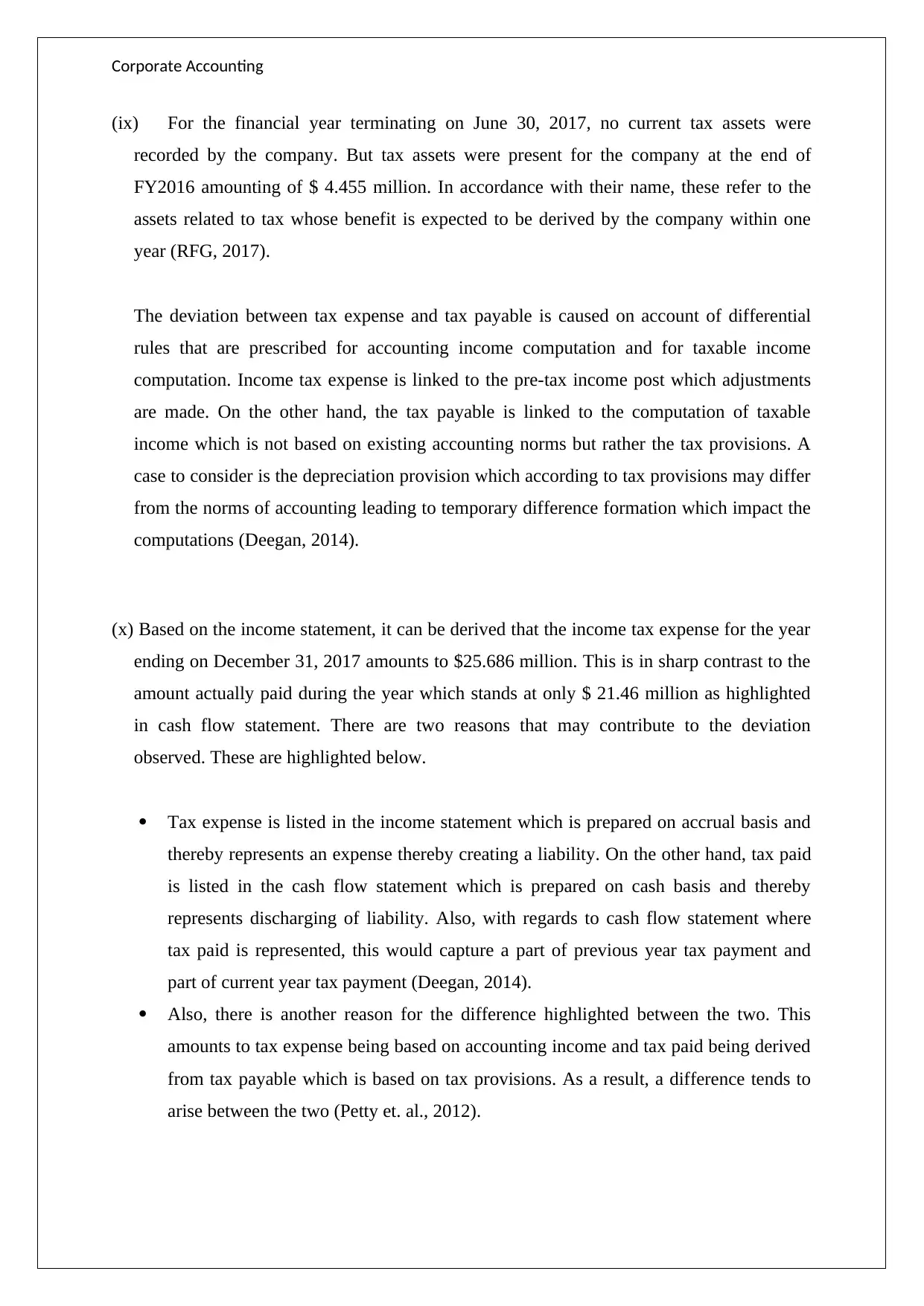
Corporate Accounting
(ix) For the financial year terminating on June 30, 2017, no current tax assets were
recorded by the company. But tax assets were present for the company at the end of
FY2016 amounting of $ 4.455 million. In accordance with their name, these refer to the
assets related to tax whose benefit is expected to be derived by the company within one
year (RFG, 2017).
The deviation between tax expense and tax payable is caused on account of differential
rules that are prescribed for accounting income computation and for taxable income
computation. Income tax expense is linked to the pre-tax income post which adjustments
are made. On the other hand, the tax payable is linked to the computation of taxable
income which is not based on existing accounting norms but rather the tax provisions. A
case to consider is the depreciation provision which according to tax provisions may differ
from the norms of accounting leading to temporary difference formation which impact the
computations (Deegan, 2014).
(x) Based on the income statement, it can be derived that the income tax expense for the year
ending on December 31, 2017 amounts to $25.686 million. This is in sharp contrast to the
amount actually paid during the year which stands at only $ 21.46 million as highlighted
in cash flow statement. There are two reasons that may contribute to the deviation
observed. These are highlighted below.
Tax expense is listed in the income statement which is prepared on accrual basis and
thereby represents an expense thereby creating a liability. On the other hand, tax paid
is listed in the cash flow statement which is prepared on cash basis and thereby
represents discharging of liability. Also, with regards to cash flow statement where
tax paid is represented, this would capture a part of previous year tax payment and
part of current year tax payment (Deegan, 2014).
Also, there is another reason for the difference highlighted between the two. This
amounts to tax expense being based on accounting income and tax paid being derived
from tax payable which is based on tax provisions. As a result, a difference tends to
arise between the two (Petty et. al., 2012).
(ix) For the financial year terminating on June 30, 2017, no current tax assets were
recorded by the company. But tax assets were present for the company at the end of
FY2016 amounting of $ 4.455 million. In accordance with their name, these refer to the
assets related to tax whose benefit is expected to be derived by the company within one
year (RFG, 2017).
The deviation between tax expense and tax payable is caused on account of differential
rules that are prescribed for accounting income computation and for taxable income
computation. Income tax expense is linked to the pre-tax income post which adjustments
are made. On the other hand, the tax payable is linked to the computation of taxable
income which is not based on existing accounting norms but rather the tax provisions. A
case to consider is the depreciation provision which according to tax provisions may differ
from the norms of accounting leading to temporary difference formation which impact the
computations (Deegan, 2014).
(x) Based on the income statement, it can be derived that the income tax expense for the year
ending on December 31, 2017 amounts to $25.686 million. This is in sharp contrast to the
amount actually paid during the year which stands at only $ 21.46 million as highlighted
in cash flow statement. There are two reasons that may contribute to the deviation
observed. These are highlighted below.
Tax expense is listed in the income statement which is prepared on accrual basis and
thereby represents an expense thereby creating a liability. On the other hand, tax paid
is listed in the cash flow statement which is prepared on cash basis and thereby
represents discharging of liability. Also, with regards to cash flow statement where
tax paid is represented, this would capture a part of previous year tax payment and
part of current year tax payment (Deegan, 2014).
Also, there is another reason for the difference highlighted between the two. This
amounts to tax expense being based on accounting income and tax paid being derived
from tax payable which is based on tax provisions. As a result, a difference tends to
arise between the two (Petty et. al., 2012).
Paraphrase This Document
Need a fresh take? Get an instant paraphrase of this document with our AI Paraphraser
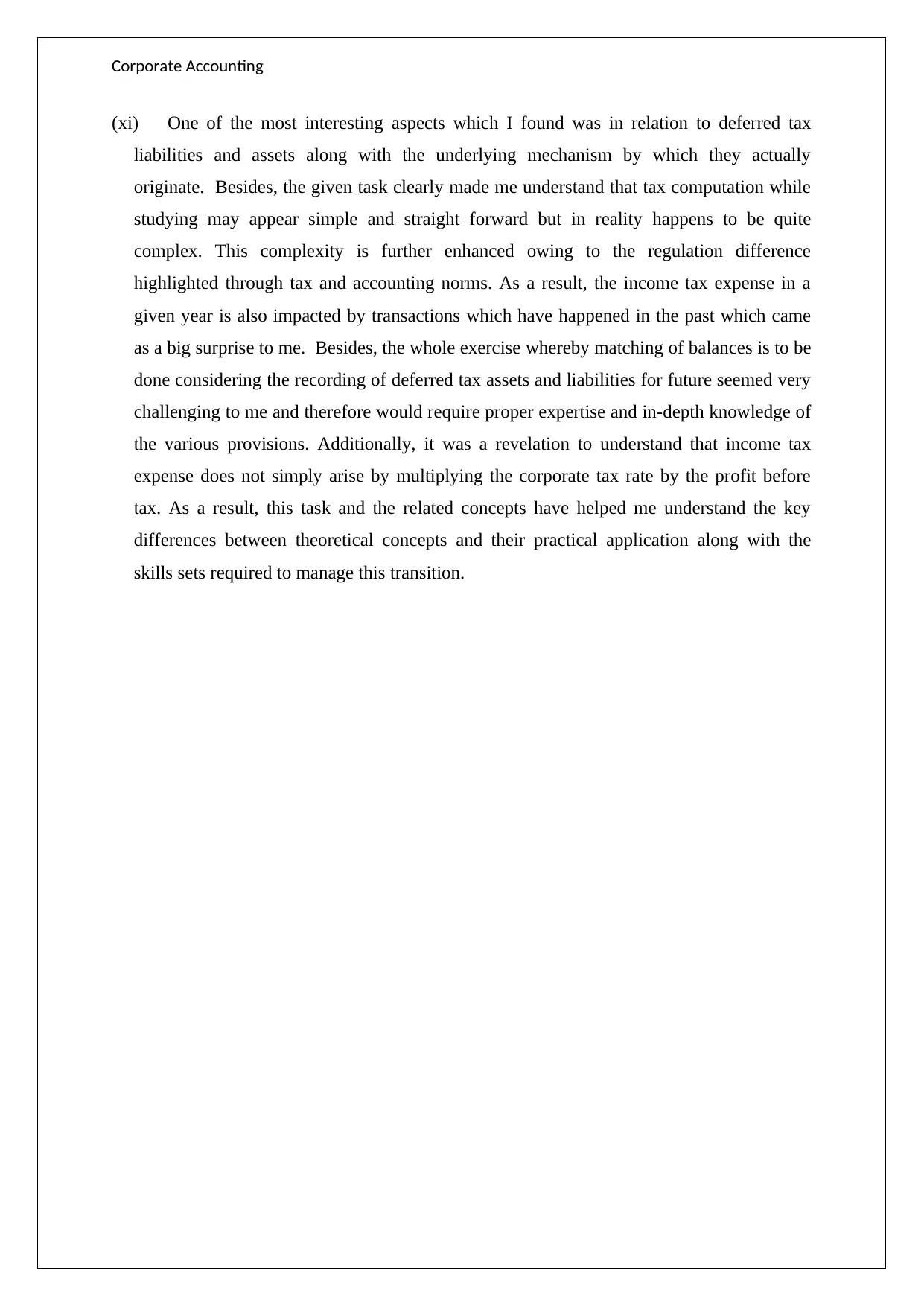
Corporate Accounting
(xi) One of the most interesting aspects which I found was in relation to deferred tax
liabilities and assets along with the underlying mechanism by which they actually
originate. Besides, the given task clearly made me understand that tax computation while
studying may appear simple and straight forward but in reality happens to be quite
complex. This complexity is further enhanced owing to the regulation difference
highlighted through tax and accounting norms. As a result, the income tax expense in a
given year is also impacted by transactions which have happened in the past which came
as a big surprise to me. Besides, the whole exercise whereby matching of balances is to be
done considering the recording of deferred tax assets and liabilities for future seemed very
challenging to me and therefore would require proper expertise and in-depth knowledge of
the various provisions. Additionally, it was a revelation to understand that income tax
expense does not simply arise by multiplying the corporate tax rate by the profit before
tax. As a result, this task and the related concepts have helped me understand the key
differences between theoretical concepts and their practical application along with the
skills sets required to manage this transition.
(xi) One of the most interesting aspects which I found was in relation to deferred tax
liabilities and assets along with the underlying mechanism by which they actually
originate. Besides, the given task clearly made me understand that tax computation while
studying may appear simple and straight forward but in reality happens to be quite
complex. This complexity is further enhanced owing to the regulation difference
highlighted through tax and accounting norms. As a result, the income tax expense in a
given year is also impacted by transactions which have happened in the past which came
as a big surprise to me. Besides, the whole exercise whereby matching of balances is to be
done considering the recording of deferred tax assets and liabilities for future seemed very
challenging to me and therefore would require proper expertise and in-depth knowledge of
the various provisions. Additionally, it was a revelation to understand that income tax
expense does not simply arise by multiplying the corporate tax rate by the profit before
tax. As a result, this task and the related concepts have helped me understand the key
differences between theoretical concepts and their practical application along with the
skills sets required to manage this transition.
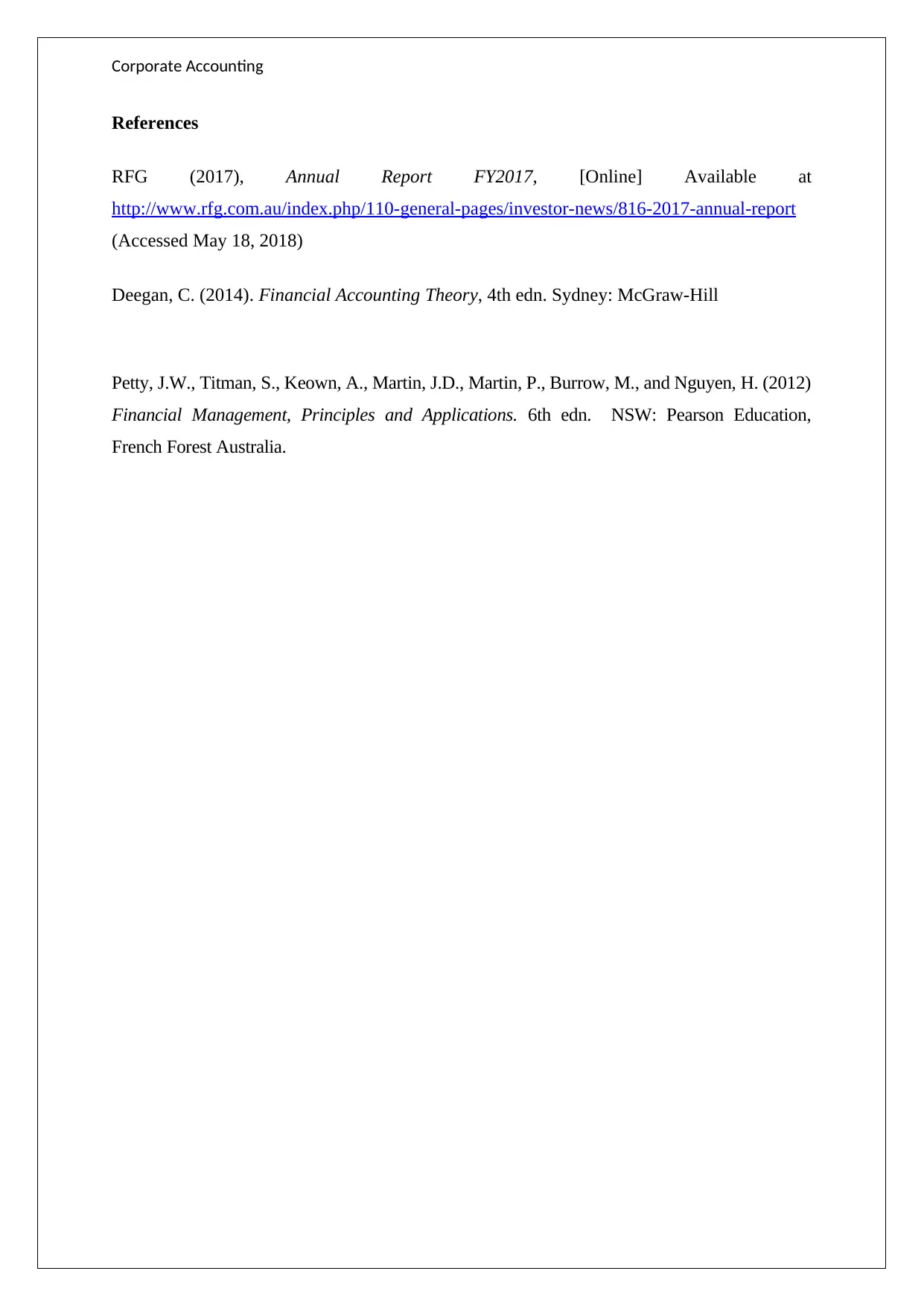
Corporate Accounting
References
RFG (2017), Annual Report FY2017, [Online] Available at
http://www.rfg.com.au/index.php/110-general-pages/investor-news/816-2017-annual-report
(Accessed May 18, 2018)
Deegan, C. (2014). Financial Accounting Theory, 4th edn. Sydney: McGraw-Hill
Petty, J.W., Titman, S., Keown, A., Martin, J.D., Martin, P., Burrow, M., and Nguyen, H. (2012)
Financial Management, Principles and Applications. 6th edn. NSW: Pearson Education,
French Forest Australia.
References
RFG (2017), Annual Report FY2017, [Online] Available at
http://www.rfg.com.au/index.php/110-general-pages/investor-news/816-2017-annual-report
(Accessed May 18, 2018)
Deegan, C. (2014). Financial Accounting Theory, 4th edn. Sydney: McGraw-Hill
Petty, J.W., Titman, S., Keown, A., Martin, J.D., Martin, P., Burrow, M., and Nguyen, H. (2012)
Financial Management, Principles and Applications. 6th edn. NSW: Pearson Education,
French Forest Australia.
⊘ This is a preview!⊘
Do you want full access?
Subscribe today to unlock all pages.

Trusted by 1+ million students worldwide
1 out of 9
Related Documents
Your All-in-One AI-Powered Toolkit for Academic Success.
+13062052269
info@desklib.com
Available 24*7 on WhatsApp / Email
![[object Object]](/_next/static/media/star-bottom.7253800d.svg)
Unlock your academic potential
Copyright © 2020–2025 A2Z Services. All Rights Reserved. Developed and managed by ZUCOL.





